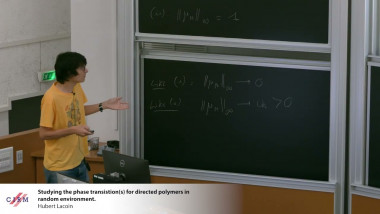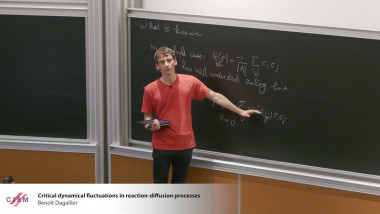
Studying the phase transistion(s) for directed polymers in random environment
De Hubert Lacoin

Critical dynamical fluctuations in reaction-diffusion processes
De Benoît Dagallier
De Arvind Ayyer
Apparaît dans la collection : 2023 - T3 - WS3 - Computer algebra for functional equations in combinatorics and physics
We define a new disordered asymmetric simple exclusion process (ASEP) with two species of particles, first-class and second-class, on a two-dimensional toroidal lattice. The dynamics is controlled by first-class particles, which only move horizontally, with forward and backward hopping rates $p_i$ and $q_i$ respectively if the particle is on row $i$. The motion of second-class particles depends on the relative position of these with respect to the first-class ones, and can be both horizontal and vertical. In the first part of my talk, I will illustrate how we used computer algebra software, specifically Mathematica and SageMath, to understand the stationary distribution of this process. We computed the partition function, as well as densities and currents of all particles in the steady state. We observed a novel mechanism we call the Scott Russell phenomenon: the current of second class particles in the vertical direction is the same as that of first-class particles in the horizontal direction. In the second part of my talk, I will show how we simulated the process and realized that the Scott Russell phenomenon also holds out of equilibrium.
This is partly joint work with P. Nadeau (European Journal of Combinatorics, 2022).
